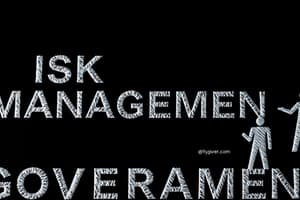Podcast
Questions and Answers
Which of the following best describes the primary goal of risk management within an organization?
Which of the following best describes the primary goal of risk management within an organization?
- To shift accountability for risks to external parties through insurance and hedging.
- To ensure compliance with all regulatory requirements and industry standards.
- To maximize sustainable value across all organizational activities by understanding and addressing potential upsides and downsides. (correct)
- To eliminate all potential risks associated with the organization's activities.
An organization is developing its corporate strategy. How should risk management be integrated into this process?
An organization is developing its corporate strategy. How should risk management be integrated into this process?
- Risk management should focus solely on identifying external threats and developing mitigation plans for those specific risks.
- Risk management should be a separate process conducted after the strategy is finalized to avoid influencing the strategic direction.
- Risk management should be used to translate the strategy into tactical and operational objectives, assigning risk management responsibilities throughout the organization. (correct)
- Risk management should be limited to the finance department to ensure financial risks are adequately addressed.
In the risk management process, after risk evaluation, what is the next immediate step, according to the diagram?
In the risk management process, after risk evaluation, what is the next immediate step, according to the diagram?
- Risk reporting
- Risk assessment
- Risk treatment
- Decision (correct)
Which sequence accurately represents the initial steps in the risk assessment phase?
Which sequence accurately represents the initial steps in the risk assessment phase?
After risk treatment, what is the next step in the presented risk management process?
After risk treatment, what is the next step in the presented risk management process?
Why do many practitioners advocate for a standardized risk management vocabulary?
Why do many practitioners advocate for a standardized risk management vocabulary?
Which of the following best describes the intended role of the UK Risk Management Standard?
Which of the following best describes the intended role of the UK Risk Management Standard?
According to the UK Risk Management Standard, what two elements combine to define risk?
According to the UK Risk Management Standard, what two elements combine to define risk?
An organization is determining the potential impact of a new regulation. They estimate the financial impact to be £80,000, with moderate disruption to operational activities. Stakeholders have voiced concerns, but not at a critical level. According to Table 3.2, how should this impact be categorized?
An organization is determining the potential impact of a new regulation. They estimate the financial impact to be £80,000, with moderate disruption to operational activities. Stakeholders have voiced concerns, but not at a critical level. According to Table 3.2, how should this impact be categorized?
What was the primary goal in creating the UK Risk Management Standard?
What was the primary goal in creating the UK Risk Management Standard?
A business is assessing the likelihood of a cyber-security breach that could compromise customer data. The IT department estimates there's a 15% chance of such an event occurring within the next year. According to Table 3.3, how should the probability of this event be categorized?
A business is assessing the likelihood of a cyber-security breach that could compromise customer data. The IT department estimates there's a 15% chance of such an event occurring within the next year. According to Table 3.3, how should the probability of this event be categorized?
When evaluating risks after analysis, which of the following considerations is LEAST relevant, according to the text?
When evaluating risks after analysis, which of the following considerations is LEAST relevant, according to the text?
Which outcome reflects why the UK Risk Management Standard needs regular updates?
Which outcome reflects why the UK Risk Management Standard needs regular updates?
An organization is deciding whether to invest in a costly new security system. They've assessed the probability of a security breach as 'Medium' and the potential consequences as 'High'. Which additional factor should they MOST carefully consider before making a final decision, according to the text?
An organization is deciding whether to invest in a costly new security system. They've assessed the probability of a security breach as 'Medium' and the potential consequences as 'High'. Which additional factor should they MOST carefully consider before making a final decision, according to the text?
In the context of risk estimation methods, what distinguishes a quantitative approach from a qualitative approach?
In the context of risk estimation methods, what distinguishes a quantitative approach from a qualitative approach?
How did companies respond to increasing competition and economic change in the post-war scientific management movement?
How did companies respond to increasing competition and economic change in the post-war scientific management movement?
Which of the following factors has NOT contributed to the increased prominence of modern risk management?
Which of the following factors has NOT contributed to the increased prominence of modern risk management?
In the context of risk management, what is the key difference between speculative and damage risks?
In the context of risk management, what is the key difference between speculative and damage risks?
How have recent developments in corporate governance rules influenced risk management practices for listed companies?
How have recent developments in corporate governance rules influenced risk management practices for listed companies?
What was the primary focus of risk management during its emergence?
What was the primary focus of risk management during its emergence?
How would you classify insurance within the context of risk management strategies employed by Phoenician merchants?
How would you classify insurance within the context of risk management strategies employed by Phoenician merchants?
In what way does the UK Risk Management Standard reflect a comprehensive approach to risk?
In what way does the UK Risk Management Standard reflect a comprehensive approach to risk?
How do larger companies in high-risk industries, such as pharmaceuticals, typically approach risk management compared to smaller retailers?
How do larger companies in high-risk industries, such as pharmaceuticals, typically approach risk management compared to smaller retailers?
What is the primary purpose of reporting residual risks to senior management?
What is the primary purpose of reporting residual risks to senior management?
According to the standard, what is the role of the risk management function within an organization?
According to the standard, what is the role of the risk management function within an organization?
What is the significance of a formal and independent audit of the risk management process?
What is the significance of a formal and independent audit of the risk management process?
A company is undergoing significant organizational restructuring. How should the risk management policy be adapted?
A company is undergoing significant organizational restructuring. How should the risk management policy be adapted?
What is the most essential administrative aspect for the effectiveness of an organization's risk management?
What is the most essential administrative aspect for the effectiveness of an organization's risk management?
Which of the following is the MOST direct benefit of risk management regarding resource allocation within an organization?
Which of the following is the MOST direct benefit of risk management regarding resource allocation within an organization?
In the context of organizational risk management, how does a comprehensive understanding of business activity and volatility primarily improve organizational functions?
In the context of organizational risk management, how does a comprehensive understanding of business activity and volatility primarily improve organizational functions?
How does effective risk management contribute to the protection and enhancement of a company's assets and image?
How does effective risk management contribute to the protection and enhancement of a company's assets and image?
Why is a systematic approach MOST important when identifying risks within an organization?
Why is a systematic approach MOST important when identifying risks within an organization?
Which section of a risk description table would MOST directly address the potential financial impact of a risk?
Which section of a risk description table would MOST directly address the potential financial impact of a risk?
In a risk management context, what is the PRIMARY purpose of defining the 'nature of risk'?
In a risk management context, what is the PRIMARY purpose of defining the 'nature of risk'?
When determining 'potential actions for improvement' in risk management, what is the main goal?
When determining 'potential actions for improvement' in risk management, what is the main goal?
What is the MOST significant reason for including 'stakeholders and their expectations' in a risk assessment?
What is the MOST significant reason for including 'stakeholders and their expectations' in a risk assessment?
What is the primary purpose of risk evaluation in the decision-making process?
What is the primary purpose of risk evaluation in the decision-making process?
Which of the following does risk treatment involve according to the content?
Which of the following does risk treatment involve according to the content?
An organization decides to purchase insurance to cover potential losses from a specific risk. Which risk treatment method does this represent?
An organization decides to purchase insurance to cover potential losses from a specific risk. Which risk treatment method does this represent?
When considering methods for risk treatment, what are the two minimum requirements?
When considering methods for risk treatment, what are the two minimum requirements?
How should companies approach upside risks (business opportunities) using the risk management process?
How should companies approach upside risks (business opportunities) using the risk management process?
What type of information about risk do the board of directors need?
What type of information about risk do the board of directors need?
Why is it important for companies to report their risk management policies and effectiveness to stakeholders?
Why is it important for companies to report their risk management policies and effectiveness to stakeholders?
Which of the following is an element of non-financial performance that stakeholders are increasingly seeking evidence of?
Which of the following is an element of non-financial performance that stakeholders are increasingly seeking evidence of?
Flashcards
Risk Management
Risk Management
The process of addressing risks to achieve sustained benefits within activities.
Types of Risks
Types of Risks
Includes externally driven, internally driven, and combined risks affecting the organization.
Objective of Risk Management
Objective of Risk Management
To add maximum sustainable value to all organizational activities.
Risk Management Process
Risk Management Process
Signup and view all the flashcards
Role of Senior Management
Role of Senior Management
Signup and view all the flashcards
High Impact Risk
High Impact Risk
Signup and view all the flashcards
Medium Impact Risk
Medium Impact Risk
Signup and view all the flashcards
Low Impact Risk
Low Impact Risk
Signup and view all the flashcards
High Probability Risk
High Probability Risk
Signup and view all the flashcards
Low Probability Risk
Low Probability Risk
Signup and view all the flashcards
Standard Vocabulary
Standard Vocabulary
Signup and view all the flashcards
UK Risk Management Standard
UK Risk Management Standard
Signup and view all the flashcards
Risk Definition
Risk Definition
Signup and view all the flashcards
Downside Risk
Downside Risk
Signup and view all the flashcards
Upside Risk
Upside Risk
Signup and view all the flashcards
Risk Management Framework
Risk Management Framework
Signup and view all the flashcards
Risk Decision Making
Risk Decision Making
Signup and view all the flashcards
Efficient Resource Allocation
Efficient Resource Allocation
Signup and view all the flashcards
Risk Assessment Process
Risk Assessment Process
Signup and view all the flashcards
Risk Identification
Risk Identification
Signup and view all the flashcards
Risk Description Format
Risk Description Format
Signup and view all the flashcards
Quantification of Risk
Quantification of Risk
Signup and view all the flashcards
Risk Treatment Strategies
Risk Treatment Strategies
Signup and view all the flashcards
Risk Reporting Stages
Risk Reporting Stages
Signup and view all the flashcards
Corporate Governance Requirements
Corporate Governance Requirements
Signup and view all the flashcards
Regular Monitoring
Regular Monitoring
Signup and view all the flashcards
Board Responsibility
Board Responsibility
Signup and view all the flashcards
Risk Management Function
Risk Management Function
Signup and view all the flashcards
Historial of Risk Management
Historial of Risk Management
Signup and view all the flashcards
Modern Risk Management Emergence
Modern Risk Management Emergence
Signup and view all the flashcards
Response Options to Risks
Response Options to Risks
Signup and view all the flashcards
Speculative vs. Damage Risks
Speculative vs. Damage Risks
Signup and view all the flashcards
Factors Influencing Risk Management
Factors Influencing Risk Management
Signup and view all the flashcards
Risk Appetite
Risk Appetite
Signup and view all the flashcards
Corporate Governance and Risk Management
Corporate Governance and Risk Management
Signup and view all the flashcards
Role of Government in Risk
Role of Government in Risk
Signup and view all the flashcards
Risk Evaluation
Risk Evaluation
Signup and view all the flashcards
Risk Treatment
Risk Treatment
Signup and view all the flashcards
Risk Avoidance
Risk Avoidance
Signup and view all the flashcards
Risk Control
Risk Control
Signup and view all the flashcards
Risk Transfer
Risk Transfer
Signup and view all the flashcards
Risk Financing
Risk Financing
Signup and view all the flashcards
Risk Reporting
Risk Reporting
Signup and view all the flashcards
Study Notes
Risk Management
- Risk management is a methodical process whereby organizations address risks associated with their activities in order to achieve sustained benefits.
- It involves all significant risks in the organizations past, present, and future.
- It considers internal risks (like processes/manufacturing/accounting) and external risks (like markets/competition).
- The goal of risk management is to add maximum sustainable value to all activities of the organization.
Modern risk management
- Risk management began to emerge in the second half of the 20th century.
- Modern risk management is a response to post-war competition and economic change.
- The ideas that were developed previously have been built on to improve assessments of risks.
- Risk management has become an integral part of the development and implementation of corporate strategy and helps with the development of organizations.
- Risk Management considers the potential upside and downside of success, increasing the probability of success and reducing the uncertainty of achieving objectives.
Process of risk management
- Risk assessment: analysis, identification, description, and estimation.
- Risk evaluation: considers threats and opportunities, decision-making, and treatment.
- Risk reporting: formal reports on the management of residual risks.
- Monitoring: ongoing monitoring of effectiveness.
Studying That Suits You
Use AI to generate personalized quizzes and flashcards to suit your learning preferences.




